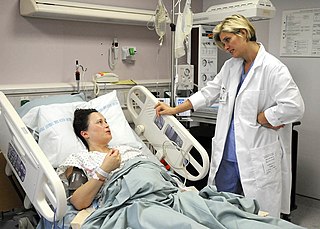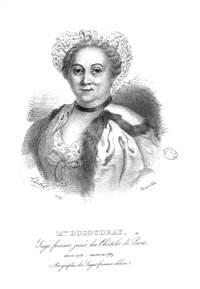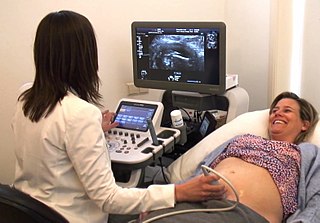
Midwifery is the health science and health profession that deals with pregnancy, childbirth, and the postpartum period, in addition to the sexual and reproductive health of women throughout their lives. In many countries, midwifery is a medical profession. A professional in midwifery is known as a midwife.
Obstetrics is the field of study concentrated on pregnancy, childbirth and the postpartum period. As a medical specialty, obstetrics is combined with gynecology under the discipline known as obstetrics and gynecology (OB/GYN), which is a surgical field.

Agnodice or Agnodike is a legendary figure credited as the first female midwife or physician in ancient Athens. Her story is told by the Roman author Gaius Julius Hyginus in his Fabulae. Agnodice is not generally believed to be a historical figure, but her story has been frequently deployed as a precedent for women practising midwifery or medicine, or as an argument against either of these.

William Smellie was a Scottish obstetrician and medical instructor who practiced and taught primarily in London. One of the first prominent male midwives in Britain, he designed an improved version of the obstetrical forceps, established safer delivery practices, and through his teaching and writing helped make obstetrics more scientifically based. He is often called the "father of British midwifery".

Ina May Gaskin is an American midwife who has been described as "the mother of authentic midwifery." She helped found the self-sustaining community, The Farm, with her husband Stephen Gaskin in 1971 where she markedly launched her career in midwifery. She is known for the Gaskin Maneuver, has written several books on midwifery and childbirth, and continues to educate society through lectures and conferences and spread her message of natural, old-age inspired, fearless childbirth.

In the United States, a Certified Nurse-Midwife (CNM) is a nurse midwife who exceeds the International Confederation of Midwives essential competencies for a midwife and is also an advanced practice registered nurse, having completed registered nursing and midwifery education leading to practice as a nurse midwife and credentialing as a Certified Nurse-Midwife. CNMs provide care of women across their lifespan, including pregnancy and the postpartum period, and well woman care and birth control. Certified Nurse-Midwives are recognized by the International Confederation of Midwives as a type of midwife in the U.S.
Pseudo-Aristotle is a general cognomen for authors of philosophical or medical treatises who attributed their work to the Greek philosopher Aristotle, or whose work was later attributed to him by others. Such falsely attributed works are known as pseudepigrapha. The term Corpus Aristotelicum covers both the authentic and spurious works of Aristotle.
Jane Sharp was an English midwife. Her work The Midwives Book: or the Whole Art of Midwifery Discovered, published in 1671, was the first on the subject to be produced by an Englishwoman.

Angélique Marguerite Le Boursier du Coudray was an influential, pioneering midwife during her lifetime, who gained fame when men were taking over the field. She rose from middle-class origins to become noticed and commissioned by King Louis XV himself.

Catharina Geertruida Schrader (1656–1746), also known as the Frisian Midwife, was a successful Dutch midwife in the Early Modern Era, known for her detailed notebooks and memoirs relating the numerous births she participated in.
The one-sex and two-sex theories are two models of human anatomy or fetal development discussed in Thomas Laqueur's book Making Sex: Body and Gender from the Greeks to Freud. Laqueur theorizes that a fundamental change in attitudes toward human sexual anatomy occurred in Europe in the 18th and 19th centuries. He draws from scholars such as Aristotle and Galen to argue that prior to the eighteenth century, women and men were viewed as two different forms of one essential sex: that is, women were seen to possess the same fundamental reproductive structure as men, the only difference being that female genitalia was inside the body, not outside of it. Anatomists saw the vagina as an interior penis, the labia as foreskin, the uterus as scrotum, and the ovaries as testicles. Laqueur uses the theory of interconvertible bodily fluids as evidence for the one-sex model. However, he claims that around the 18th century, the dominant view became that of two sexes directly opposite to each other. In his view, the departure from a one-sex model is largely because of political shifts which challenged the way women's sexuality came to be seen. One result of this was the emerging view of the female orgasm as nonessential to conception after the eighteenth century. Women and men began to be seen as opposites and each sex was compared in relation to the other. Freud's work further perpetuated the sexual socialization of women by dictating how they should feel pleasure.

Childbirth and obstetrics in Classical Antiquity were studied by the physicians of ancient Greece and Rome. Their ideas and practices during this time endured in Western medicine for centuries and many themes are seen in modern women's health. Classical Gynecology and obstetrics were originally studied and taught mainly by midwives in the ancient world, but eventually scholarly physicians of both sexes became involved as well. Obstetrics is traditionally defined as the surgical specialty dealing with the care of a woman and her offspring during pregnancy, childbirth and the puerperium (recovery). Gynecology involves the medical practices dealing with the health of women's reproductive organs and their breasts.

Levinus Lemnius was a Dutch physician and author.
Midwifery in the Middle Ages impacted women's work and health prior to the professionalization of medicine. During the Middle Ages in Western Europe, people relied on the medical knowledge of Roman and Greek philosophers, specifically Galen, Hippocrates, and Aristotle. These medical philosophers focused primarily on the health of men, and women's health issues were understudied. Thus, these philosophers did not focus on the baby and they encouraged women to handle women's issues. In fact, William L. Minkowski asserted that a male's reputation was negatively affected if he associated with or treated pregnant patients. Resultantly, male physicians did not engage with pregnant patients, and women had a place in medicine as midwives. Myriam Greilsammer notes that an additional opposition to men's involvement in childbearing was that men should not associate with female genitalia throughout the secret practices of childbearing. The prevalence of this mindset allowed women to continue the practice of midwifery throughout most of the Medieval era with little or no male influence on their affairs. Minkowski writes that in Guy de Chauliac's fourteenth-century work Chirurgia magna, "he wrote that he was unwilling to discourse on midwifery because the field was dominated by women." However, changing views of medicine caused the women's role as midwife to be pushed aside as the professionalization of medical practitioners began to go up.
Medieval contraception is a debated topic among historians, though methods of contraception have been developed not just in modern times. In ancient times, women attempted to protect themselves from unwanted pregnancy with various means and practices, as evidenced by ancient records. Ancient and medieval manuscripts provide glimpses into diverse birth control practices.
Sarah Stone was an English midwife and author during the early modern period. She advocated for the better education of female midwives, speaking out against the rise of male-midwives in her line of work. She is considered a "champion of her sex and a disciple and advocate of the Enlightenment."

Elizabeth Nihell was an Englishwoman from London, who was a famous midwife, obstetrics writer, and polemicist. She was most famous for her outspoken stance against male midwives and for her publications.

A midwife is a health professional who cares for mothers and newborns around childbirth, a specialization known as midwifery.

A nurse midwife is both a nurse and a midwife, having completed nursing and midwifery education leading to practice as a nurse midwife and sometimes credentialed in the specialty. Nurse midwives provide care of women across the lifespan, including during pregnancy and the postpartum period, and well woman care and birth control.
Early Modern Europe marked a period of transition within the medical world. Universities for doctors were becoming more common and standardized training was becoming a requirement. During this time, a few universities were beginning to train women as midwives, but rhetoric against women healers was increasing. The literature against women in medicine started in the 13th century, and the Early Modern period gave way to a widespread call for licensing and proper training for midwives, which was largely unavailable.











